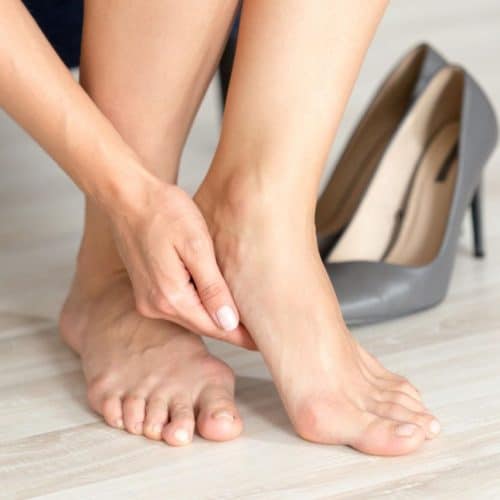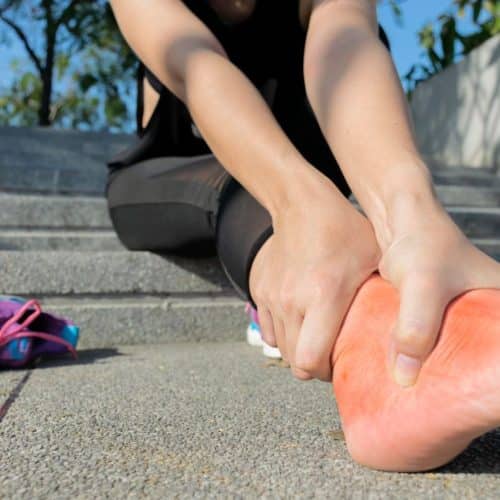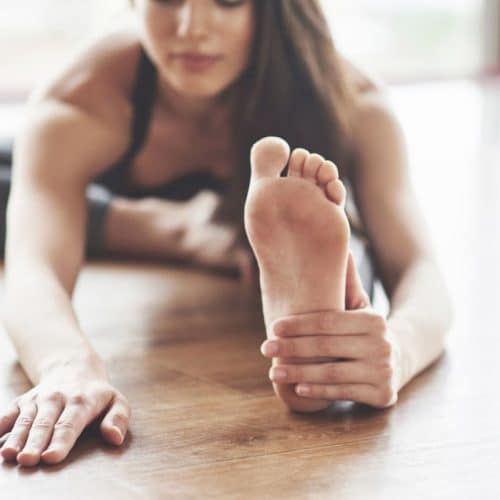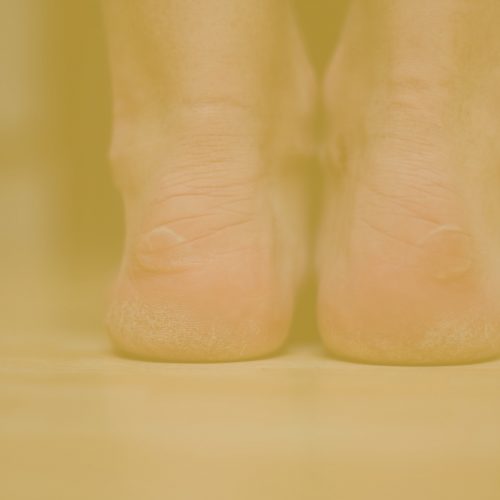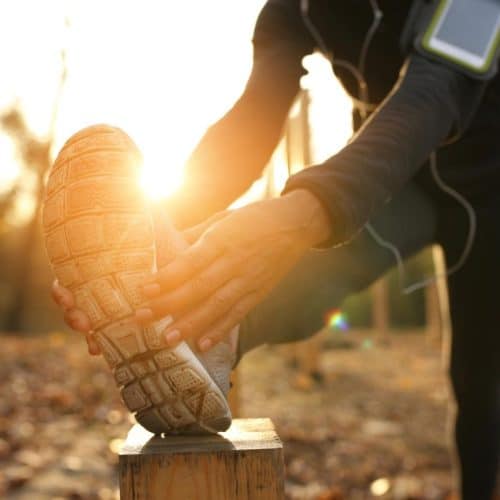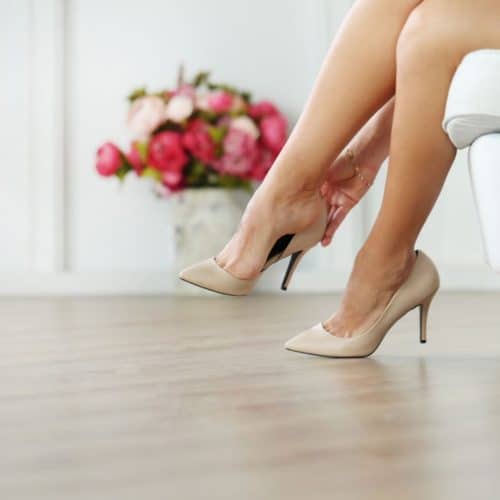Plantar fasciitis is a very frequent foot problem that affects a significant number of people all over the world. It is frequently diagnosed based on the characteristic symptoms that it manifests, which can have a considerable influence on one’s day-to-day activities. In this blog post, we will investigate the basic symptoms of plantar fasciitis in further detail and throw light on several important aspects of this ailment.
Primary Symptoms of Plantar Fasciitis
Plantar fasciitis is a prevalent foot ailment that has become a topic of concern for many. While there are several symptoms associated with this condition, two stand out as the most common and often the most debilitating. In this section, we’ll take a closer look at these primary symptoms, offering a comprehensive understanding of what they entail.
1. Pain Localised at the Heel
- Description: This pain is often described as a sharp, stabbing sensation right at the bottom of the heel. It’s not a dull ache but a more intense pain that can make putting weight on the foot extremely uncomfortable.
- When it’s most pronounced: The pain is typically most severe when taking the first few steps after waking up in the morning. This is because the plantar fascia ligament, which runs along the bottom of the foot, tightens up overnight. When you start walking after waking up, the sudden stretching can cause significant pain.
- Activities that exacerbate it: Apart from the morning, this heel pain can also be triggered by long periods of standing, climbing stairs, or after intense activities like running or jumping.
2. Pain After Periods of Inactivity
- Description: This isn’t just about the morning stiffness. Anytime you’ve been off your feet for a while, whether it’s sitting at your desk for hours or even after a long drive, the pain can flare up once you start moving again.
- The reason behind it: The plantar fascia tends to contract and tighten when not in use. So, after periods of inactivity, when you suddenly put weight on it or stretch it, the ligament experiences a sudden strain, leading to pain.
- Managing the pain: One way to mitigate this pain is by doing gentle foot stretches before standing up or walking after long periods of rest. This can help in gradually loosening the ligament and reducing the intensity of the pain.
These two primary symptoms of plantar fasciitis can significantly impact an individual’s quality of life. Recognising them early on and understanding their nuances can be the first step towards seeking appropriate treatment and finding relief. If you or someone you know is experiencing these symptoms, it’s crucial to consult a healthcare professional for a proper diagnosis and guidance.
Causes of Plantar Fasciitis
1. Strain Injury
- Description: One of the primary causes of plantar fasciitis is a strain injury. This involves micro-tears in the ligament as it attaches to the heel bone or other areas of tightness on the sole of the foot.
- How it occurs: Repetitive stress, such as excessive walking, running, or jumping without proper foot support, can lead to these micro-tears. Over time, these small injuries can accumulate, leading to inflammation and pain.
2. Foot Mechanics
- Description: The structure of your foot can play a significant role in the development of plantar fasciitis.
- Flat Feet or High Arches: Individuals with flat feet or exceptionally high arches are more prone to plantar fasciitis. These foot structures can place additional strain on the plantar fascia ligament.
- Walking Pattern: An abnormal walking pattern, such as overpronation (where the foot rolls inward excessively), can also put extra stress on the plantar fascia.
3. Improper Footwear
- Description: Shoes that lack proper support, especially in the arch and heel areas, can significantly contribute to plantar fasciitis.
- Why it matters: Wearing unsupportive shoes, particularly when engaging in physical activities, can lead to undue stress on the foot, increasing the risk of strain injuries.
4. Excessive Weight
- Description: Extra weight can pressure the feet, especially the plantar fascia.
- Obesity and Plantar Fasciitis: Obesity is a known risk factor for plantar fasciitis. The added weight can strain the ligament, leading to inflammation and pain.
5. Age Factor
- Description: Plantar fasciitis is more common in middle-aged individuals.
- Reason: As we age, the elasticity of our ligaments and tendons decreases, making them more susceptible to injuries. The plantar fascia is no exception to this rule.
6. Occupational Hazards
- Description: Certain jobs require individuals to be on their feet for extended periods.
- Jobs at Risk: Teachers, nurses, factory workers, and others who spend much time walking or standing on hard surfaces can be more prone to developing plantar fasciitis.
While a combination of factors can cause plantar fasciitis, understanding these root causes can aid in its prevention. We can reduce the risk of this painful condition by making informed choices about footwear, being mindful of our foot mechanics, and addressing any underlying issues. If you suspect you’re at risk, it’s always best to consult a healthcare professional for guidance.
Duration and Recovery of Plantar Fasciitis
1. Typical Duration
- Description: The duration of plantar fasciitis can vary widely among individuals. For some, the condition may resolve within a few weeks; for others, it can linger for several months or even longer.
- Average Timeline: Most people experience relief from symptoms within 6 to 12 months with appropriate treatment.
2. Factors Influencing Recovery
- Early Intervention: Seeking treatment soon after the onset of symptoms can lead to a quicker recovery. Early intervention can prevent the condition from worsening and reduce the overall healing time.
- Severity of the Condition: Mild cases of plantar fasciitis may resolve faster than more severe cases where the ligament has sustained significant strain or micro-tears.
- Consistency in Treatment: Adhering to prescribed treatments, such as physical therapy exercises, wearing orthotics, or following stretching routines, can expedite recovery.
- Underlying Health Conditions: Conditions like obesity, diabetes, or arthritis can prolong the healing process due to increased inflammation or reduced blood flow to the affected area.
3. Chronic Plantar Fasciitis
- Description: Despite treatment, plantar fasciitis can sometimes become a chronic condition.
- Factors: Chronic cases often result from not addressing the root causes, such as wearing unsupportive footwear or not modifying activities that exacerbate the condition.
- Management: Chronic plantar fasciitis may require more intensive treatments, such as shock wave therapy, platelet-rich plasma (PRP) injections, or, in rare cases, surgery.
4. Reinjury and Recurrence
- Description: Even after recovery, there’s a possibility of recurrence if preventive measures are not taken.
- Prevention: To prevent reinjury, it’s crucial to continue with foot exercises, wear supportive footwear, and be mindful of activities that put excessive strain on the feet.
While the duration of plantar fasciitis can vary, understanding the factors that influence recovery can provide a clearer picture of the healing timeline. It’s essential to be patient and consistent with treatment and to consult with healthcare professionals regularly to monitor progress. Remember, every individual’s healing journey is unique, and what works best for one person might differ for another.
Prevention of Plantar Fasciitis
1. Wear Supportive Footwear
Description: The importance of wearing shoes with proper arch support and cushioning cannot be overstated.
Tips:
- Avoid wearing high heels or shoes with thin soles for extended periods.
- Invest in shoes designed for your specific activity, such as running shoes for runners.
- Replace worn-out shoes that no longer provide adequate support.
2. Maintain a Healthy Weight
- Description: Excess weight can strain the plantar fascia, increasing the risk of inflammation.
- Recommendation: Adopt a balanced diet and regular physical activity to maintain a healthy weight, reducing foot stress.
3. Regular Foot and Calf Stretches
Description: Stretching can help improve the flexibility of the Achilles tendon and plantar fascia, reducing the risk of strain.
Simple Exercises:
- Calf stretches against a wall.
- Rolling a tennis ball or frozen water bottle under the foot.
- Pulling the toes towards the ankle with a towel.
4. Avoid Prolonged Standing on Hard Surfaces
- Description: Standing for extended periods, especially on concrete or other hard surfaces, can strain the plantar fascia.
- Solution: If your job requires standing, use cushioned mats and take regular breaks to move around and stretch.
5. Gradually Increase Physical Activities
- Description: Suddenly increasing the intensity or duration of physical activities can lead to strain injuries.
- Recommendation: Whether you’re taking up a new sport or increasing your exercise regimen, gradually allow your body to adjust.
6. Use Orthotic Inserts
- Description: Custom-made or over-the-counter orthotic inserts can provide additional arch support and cushioning.
- Benefit: They distribute pressure more evenly across the foot, reducing the risk of strain on the plantar fascia.
7. Stay Hydrated
- Description: Proper hydration can help maintain the elasticity of the plantar fascia.
- Tip: Drink plenty of water throughout the day, especially when engaging in physical activities.
8. Warm-Up Before Exercise
- Description: Warming up prepares the muscles, tendons, and ligaments for physical activity.
- Recommendation: Before any strenuous activity, spend a few minutes doing light exercises and stretches to prevent injuries.
Prevention is always better than cure. Adopting these preventive measures can significantly reduce the risk of developing plantar fasciitis. Remember, our feet carry the weight of our entire body, and caring for them is essential for overall well-being. Consulting a podiatrist or healthcare practitioner is always wise if you have concerns about your foot health or plantar fasciitis.
Conclusion
In conclusion, plantar fasciitis, though painful, is a treatable condition. Recognising the symptoms early and seeking appropriate treatment can help alleviate the pain and prevent further complications. If you suspect you have plantar fasciitis, it’s essential to consult with a healthcare practitioner to get a proper diagnosis and treatment plan.



